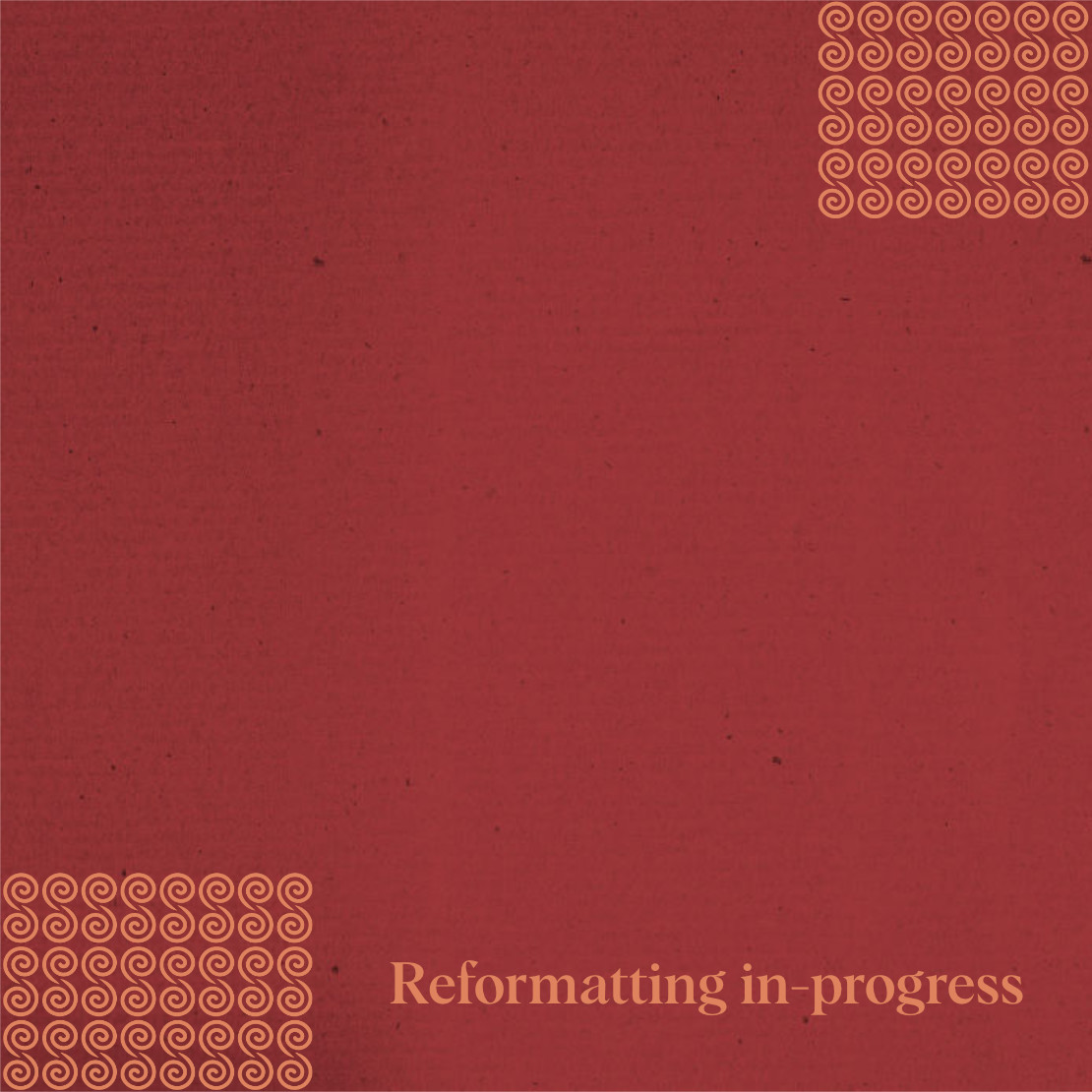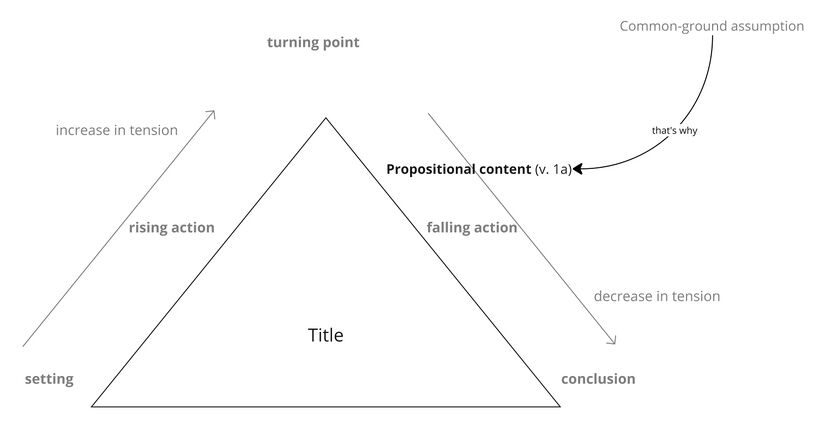Psalm 8 Story Behind
About the Story Behind Layer
The Story Behind the Psalm shows how each part of the psalm fits together into a single coherent whole. Whereas most semantic analysis focuses on discrete parts of a text such as the meaning of a word or phrase, Story Behind the Psalm considers the meaning of larger units of discourse, including the entire psalm.
The goal of this layer is to reconstruct and visualize a mental representation of the text as the earliest hearers/readers might have conceptualized it. We start by identifying the propositional content of each clause in the psalm, and then we identify relevant assumptions implied by each of the propositions. During this process, we also identify and analyze metaphorical language (“imagery”). Finally, we try to see how all of the propositions and assumptions fit together to form a coherent mental representation. The main tool we use for structuring the propositions and assumptions is a story triangle, which visualizes the rise and fall of tension within a semantic unit. Although story triangles are traditionally used to analyze stories in the literary sense of the word, we use them at this layer to analyze “stories” in the cognitive sense of the word—i.e., a story as a sequence of propositions and assumptions that has tension.
Summary Triangle
The story triangle below summarises the story of the whole psalm. We use the same colour scheme as in Participant Analysis. The star icon along the edge of the story-triangle indicates the point of the story in which the psalm itself (as a speech event) takes place. We also include a theme at the bottom of the story. The theme is the main message conveyed by the story-behind.
| Story Triangles legend | |
|---|---|
| Propositional content (verse number) | Propositional content, the base meaning of the clause, is indicated by bold black text. The verse number immediately follows the correlating proposition in black text inside parentheses. |
| Common-ground assumption | Common-ground assumptions[1] are indicated by gray text. |
| Local-ground assumption | Local-ground assumptions[2] are indicated by dark blue text. |
| Playground assumption | Playground assumptions[3] are indicated by light blue text. |
| The point of the story at which the psalm takes place (as a speech event) is indicated by a gray star. | |
| If applicable, the point of the story at which the psalm BEGINS to take place (as a speech event) is indicated with a light gray star. A gray arrow will travel from this star to the point at which the psalm ends, indicated by the darker gray star. | |
| A story that repeats is indicated by a circular arrow. This indicates a sequence of either habitual or iterative events. | |
| A story or event that does not happen or the psalmist does not wish to happen is indicated with a red X over the story triangle. | |
| Connections between propositions and/or assumptions are indicated by black arrows with small text indicating how the ideas are connected. | |
| Note: In the Summary triangle, highlight color scheme follows the colors of participant analysis. | |
Background ideas
Following are the common-ground assumptionsCommon-ground assumptions include information shared by the speaker and hearers. In our analysis, we mainly use this category for Biblical/Ancient Near Eastern background. which are the most helpful for making sense of the psalm.
- The common practice of kings and lords is to accrue glory for themselves, not to bestow it upon others.
- YHWH gave dominion to (i.e., bestowed glory on) the sun, moon, and stars (Gen 1:16-18; Ps 136:8-9), which are associated with heavenly beings (cf. Job 38:7; Rev 1:20; cf. COS I:181).
- YHWH created humans as his image and gave them universal dominion (cf. Gen 1:26ff).
- YHWH promised to give David's dynasty universal dominion (cf. Pss 2; 72; 89; 110).
- "Portrayal of man in his paradisal splendour was especially linked in the ancient world with the royal office" (Eaton 1967, 45).
- Wild animals are sometimes used to depict the enemies of God's people (e.g., Pss 7:3; 10:9; 17:12; 22:13, 17, 22; 80:14; cf. Dan 6-7).
Background situation
The background situation is the series of events leading up to the time in which the psalm is spoken. These are taken from the story triangle – whatever lies to the left of the star icon.

Expanded Paraphrase
The expanded paraphrase seeks to capture the implicit information within the text and make it explicit for readers today. It is based on the CBC translation and uses italic text to provide the most salient background information, presuppositions, entailments, and inferences.
| Expanded paraphrase legend | |
|---|---|
| Close but Clear (CBC) translation | The CBC, our close but clear translation of the Hebrew, is represented in bold text. |
| Assumptions | Assumptions which provide background information, presuppositions, entailments, and inferences are represented in italics. |
| Text (Hebrew) | Verse | Expanded Paraphrase |
|---|---|---|
| לַמְנַצֵּ֥חַ עַֽל־הַגִּתִּ֗ית מִזְמ֥וֹר לְדָוִֽד׃ | 1 | For the director, on the gittith, a psalm by David to whose offspring YHWH promised to give universal dominion. |
| יְהוָ֤ה אֲדֹנֵ֗ינוּ מָֽה־אַדִּ֣יר שִׁ֭מְךָ בְּכָל־הָאָ֑רֶץ אֲשֶׁ֥ר תְּנָ֥ה ה֝וֹדְךָ֗ עַל־הַשָּׁמָֽיִם׃ | 2 | YHWH, our lord, you who are the great king over all creation and over your people, Israel, how majestic is your name in all the earth, you whose royal glory is bestowed on the heavens, on the sun, moon, and stars and other heavenly beings, on whom you have conferred some of your royal authority. |
| מִפִּ֤י עֽוֹלְלִ֨ים ׀ וְֽיֹנְקִים֮ יִסַּ֪דְתָּ֫ עֹ֥ז לְמַ֥עַן צוֹרְרֶ֑יךָ לְהַשְׁבִּ֥ית א֝וֹיֵ֗ב וּמִתְנַקֵּֽם׃ | 3 | YHWH, you are a king, whose people are under attack by an enemy, and kings build fortresses and fortifications to repel enemy attacks. And so, You have founded a fortress to protect your people and repel the enemy. This fortress is not built on the size of your people's army or on the eloquence of their orators, but from the cries that come out of the mouths of nursing children who, as the weakest and most vulnerable of the human race, represent your people as dependent on you for protection. Through their humble cries for help, you have founded a fortress on account of your adversaries, in order to put an end to a vengeful enemy. |
| כִּֽי־אֶרְאֶ֣ה שָׁ֭מֶיךָ מַעֲשֵׂ֣י אֶצְבְּעֹתֶ֑יךָ יָרֵ֥חַ וְ֝כוֹכָבִ֗ים אֲשֶׁ֣ר כּוֹנָֽנְתָּה׃ | 4 | When I look up at the night-time sky and see your heavens, that which your fingers made, the moon and stars which you have established, I am awestruck by the glory and power which you have bestowed on the heavenly realm (v. 2b) and I think |
| מָֽה־אֱנ֥וֹשׁ כִּֽי־תִזְכְּרֶ֑נּוּ וּבֶן־אָ֝דָ֗ם כִּ֣י תִפְקְדֶֽנּוּ׃ | 5 | "What is mankind that you should consider them, or a human being, that you should be mindful of him?" Whereas the heavens and the creatures in them are glorious and powerful, humans are weak and helpless. Why should you pay attention to us? |
| וַתְּחַסְּרֵ֣הוּ מְּ֭עַט מֵאֱלֹהִ֑ים וְכָב֖וֹד וְהָדָ֣ר תְּעַטְּרֵֽהוּ׃ | 6 | And yet you created humans as your image, and, in so doing, you caused him to lack being a heavenly being who live in the heavens at which I am gazing and on whom you have conferred glory (v. 2) by only a little, and whereas kings normally choose powerful and impressive representatives for themselves, you have chosen weak and unimpressive humanity, and you crowned him like a king with royal glory and majesty and so gave him the right to rule over your creation. |
| תַּ֭מְשִׁילֵהוּ בְּמַעֲשֵׂ֣י יָדֶ֑יךָ כֹּ֝ל שַׁ֣תָּה תַֽחַת־רַגְלָֽיו׃ | 7 | You caused him to rule that which your hands made when you blessed him and told him to subdue the earth and rule over all of its creatures. Just as a conqueror's enemies are placed under his feet, so You placed everything under his feet. |
| צֹנֶ֣ה וַאֲלָפִ֣ים כֻּלָּ֑ם וְ֝גַ֗ם בַּהֲמ֥וֹת שָׂדָֽי׃ | 8 | You gave him dominion over domestic animals such as Sheep and goats and cattle – all of them, and not just domestic animals, but even wild animals, |
| צִפּ֣וֹר שָׁ֭מַיִם וּדְגֵ֣י הַיָּ֑ם עֹ֝בֵ֗ר אָרְח֥וֹת יַמִּֽים׃ | 9 | and not just land animals, but also birds in the sky and fish in the sea, that which traverses the paths of the sea. As I, David, reflect on the universal dominion which you gave to humanity, I think about the universal dominion which you promised to my dynasty. You chose me, a lowly human, the least in my family, to rule over your people, Israel. My dynasty will last forever, and my descendant will reign until all his enemies are put under his feet. |
| יְהוָ֥ה אֲדֹנֵ֑ינוּ מָֽה־אַדִּ֥יר שִׁ֝מְךָ֗ בְּכָל־הָאָֽרֶץ׃ | 10 | YHWH, our lord, you are not like most lords who accrue glory to themselves and abuse their subjects. Instead, you share your glory with your subjects, and you demonstrate your power in weakness. how majestic is your name in all the earth. |
There are currently no Imagery Tables available for this psalm.
Bibliography
- Alter, Robert. 1985. The Art of Biblical Poetry. New York: Basic Books.
- Anderson, A. A. 1972. The Book of Psalms. Vol. 1. NCBC. Greenwood, SC: Attic.
- Baethgen, Friedrich. 1904. Die Psalmen. Göttingen: Vandenhoeck und Ruprecht.
- Barthélemy, Dominique. 2005. Critique Textuelle de l’Ancien Testament. Tome 4: Psaumes. Fribourg, Switzerland: Academic Press.
- Boyd, Stephen W. 2017. “The Binyanim (Verbal Stems).” In Where Shall Wisdom Be Found? A Grammatical Tribute to Professor Stephen A. Kaufman, edited by Hélène M. Dallaire, Benjamin J. Noonan, and Jennifer E. Noonan. Eisenbrauns.
- Bratcher, Robert G., and William D. Reyburn. 1991. A Translator's Handbook on the Book of Psalms. New York: UBS Handbook Series.
- Briggs, Charles and Emilie Briggs. 1906. A Critical and Exegetical Commentary on the Book of Psalms. International Critical Commentary. New York: C. Scribner’s Sons.
- Brown, William. 2002. Seeing the Psalms: A Theology of Metaphor. Louisville: Westminster John Knox Press.
- Brueggemann, Walter, and William H. Bellinger Jr. 2014. Psalms. New Cambridge Bible Commentary. Cambridge: Cambridge University Press.
- Craigie, Peter C. 2004. Word Biblical Commentary: Psalms 1–50. 2nd ed. Vol. 19. Nashville, TN: Nelson Reference & Electronic.
- Dahood, Mitchell J. 1966. The Anchor Bible: Psalms I, 1-50. Garden City, NY: Doubleday.
- Delitzsch, Franz. 1871. Biblical Commentary on the Psalms. Vol. 1. Edinburgh: T&T Clark.
- Delitzsch, Franz. 1883. A Commentary on the Psalms. New York: Funk and Wagnalls.
- Eaton, John. 2003. The Psalms: A Historical and Spiritual Commentary with an Introduction and New Translation. London; New York: T&T Clark.
- Fokkelman, J.P. 2003. Major Poems of the Hebrew Bible: At the Interface of Prosody and Structural Analysis (Vol 3: The Remaining 65 Psalms). Vol. 3. Studia Semitica Neerlandica. Van Gorcum.
- Gentry, Peter J. 1998. “The System of the Finite Verb in Classical Hebrew.” Hebrew Studies 39:7–39.
- Gentry, Peter J., and Stephen J. Wellum. 2012. Kingdom Through Covenant: A Biblical-Theological Understanding of the Covenants. Wheaton: Crossway.
- Gesenius, W. Donner, H. Rüterswörden, U. Renz, J. Meyer, R. (eds.). 2013. Hebräisches und aramäisches Handwörterbuch über das Alte Testament. Berlin: Springer.
- Hengstenberg, Ernst Wilhelm. 1863. Commentary on the Psalms. Vol. 1. Edinburgh: T. & T. Clark.
- Holmstedt, Robert D. 2016. The Relative Clause in Biblical Hebrew. Indiana: Eisenbrauns.
- Hossfeld, Frank-Lothar, and Erich Zenger. 1993. Die Psalmen I: Psalm 1–50. Neue Echter Bibel. Würzburg: Echter.
- Hupfeld, Hermann. 1855. Die Psalmen. Vol. 1. Gotha: Friedrich Andreas Perthes.
- Ibn Ezra. Ibn Ezra on Psalms.
- Jacobson, R. A. 2014. "Psalm 8," in N. DeClaissé-Walford, R. A. Jacobson & B. L. Tanner (eds.) The Book of Psalms. Grand Rapids, MI: Eerdmans.
- Jero, Christopher. 2017. “Tense, Mood, and Aspect in the Biblical Hebrew Verbal System.” In Where Shall Wisdom Be Found? A Grammatical Tribute to Professor Stephen A. Kaufman, edited by Hélène M. Dallaire, Benjamin J. Noonan, and Jennifer E. Noonan. Eisenbrauns.
- Keel, Othmar. 1997. The Symbolism of the Biblical World: Ancient Near Eastern Iconography and the Book of Psalms. Winona Lake: Eisenbrauns.
- Keener, Hubert James. 2013. A Canonical Exegesis of the Eighth Psalm: YHWH’s Maintenance of the Created Order Through Divine Reversal. Vol. 00009. Winona Lake, Indiana: Eisenbrauns.
- Kraus, Hans-Joachim. 1988. Psalms 1–59. Minneapolis: Fortress.
- Kraut, Judah. 2010. “The Birds and the Babes: The Structure and Meaning of Psalm 8.” The Jewish Quarterly Review. Vol. 100, No. 1, 10-24.
- Lunn, Nicholas P. 2006. Word-Order Variation in Biblical Hebrew Poetry: Differentiating Pragmatics and Poetics. Paternoster Biblical Monographs. Milton Keynes: Paternoster.
- Perowne, J. J. Stewart. 1870. The Book of Psalms: A New Translation with Introductions and Notes, Explanatory and Critical. Vol. I. London: Bell and Daldy.
- Robar, Elizabeth. 2013. “Wayyiqol as an Unlikely Preterite.” Journal of Semitic Studies 58 (1): 21–42.
- ________. 2015. The Verb and the Paragraph in Biblical Hebrew: A Cognitive-Linguistic Approach. Vol. 78. Studies in Semitic Languages and Linguistics. Leiden: Brill.
- Rogerson, J. W., and J. W. McKay. 1977. Psalms. Vol. 1. The Cambridge Bible Commentary on the New English Bible. Cambridge: Cambridge University Press.
- Ross, Allen P. 2011. A Commentary on the Psalms 1-41. Vol. 1. Grand Rapids, MI: Kregel.
- Sarna, Nahum M. 1993. On the Book of Psalms: Exploring the Prayers of Ancient Israel. New York: Schocken.
- Smith, Mark S. 1997. "Psalm 8:2b-3: New Proposals for Old Problems." The Catholic Biblical Quarterly. Vol. 59, No. 4, 637-641.
- Sommer, Benjamin. 2020. “Hebrew Humanism. A Commentary on Psalm 8.” 11: 7*-32*. Studies in Bible and Exegesis (עיוני מקרא ופרשנות).
- Stec, David M. 2004. The Targum of Psalms: Translated, with a Critical Introduction, Apparatus, and Notes. Collegeville, MN: Liturgical Press.
- Tate, Marvin E. 2001. "An Exposition of Psalm 8." Perspectives in Religious Studies. 28 (4), 343-359.
- Terrien, Samuel L. 2003. The Psalms: Strophic Structure and Theological Commentary. ECC. Grand Rapids: Eerdmans.
- VanGemeren, Willem. 2008. Psalms: The Expositor's Bible Commentary. Grand Rapids: Zondervan.
- Waltke, Bruce K., J. M. Houston, and Erika Moore. 2010. The Psalms as Christian Worship: A Historical Commentary. Grand Rapids, Mich: William B. Eerdmans Pub. Co.
- Whitekettle, Richard. 2006. “Taming the Shrew, Shrike, and Shrimp: The Form and Function of Zoological Classification in Psalm 8.” JBL 125: pp. 749-65.
- Wilson, Gerald H. 2002. The NIV Application Commentary: Psalms. Vol. 1. Grand Rapids: Zondervan.
- Young, Dwight W. 1960. “Notes on the Root Ntn in Biblical Hebrew.” Vetus Testamentum 10, no. 4: 457–59.
Footnotes
- ↑ Common-ground assumptions include information shared by the speaker and hearers. In our analysis, we mainly use this category for Biblical/ANE background - beliefs and practices that were widespread at this time and place. This is the background information necessary for understanding propositions that do not readily make sense to those who are so far removed from the culture in which the proposition was originally expressed.
- ↑ Local-ground assumptions are those propositions which are necessarily true if the text is true. They include both presuppositions and entailments. Presuppositions are those implicit propositions which are assumed to be true by an explicit proposition. Entailments are those propositions which are necessarily true if a proposition is true.
- ↑ Whereas local-ground assumptions are inferences which are necessarily true if the text is true, play-ground assumptions are those inferences which might be true if the text is true.








